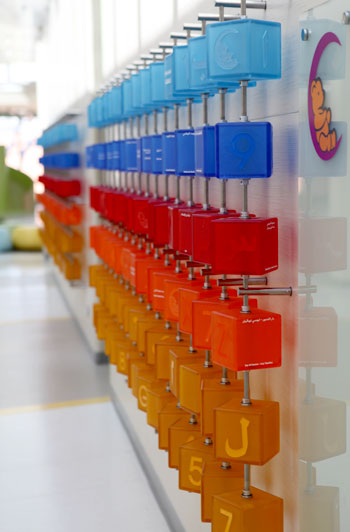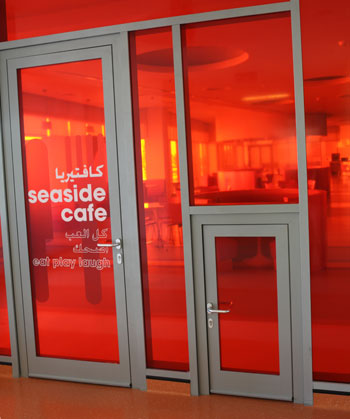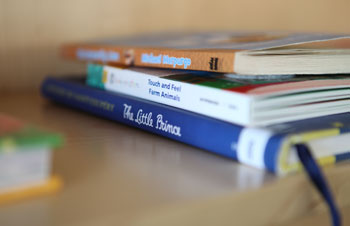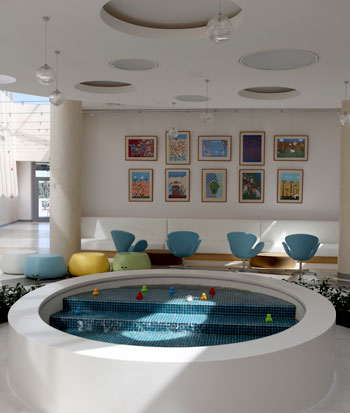Child Care in Kuwait: Palliative Care for Children
Interview with Margaret Al-Sayer, Founding Director of Bayt Abdullah Children’s Hospice. Bayt Abdullah Children’s Hospice in Kuwait is a place where special care is given; pediatric palliative care for children. A child is different from an adult; a child needs the specialist care of trained child doctors. Bayt Abdullah was designed to help those children who need it the most.
Would you briefly talk about your journey to where you are at today, which took twenty years to accomplish?
We started supporting children in hospital and their famiies in 1989 after our younger son had been taken to the hospital suffering from asthma. It was his first bout of asthma and he was quite seriously ill. He was taken into the Amiri hospital, and had excellent medical care. As soon as he started to feel better, he wanted to play, and the hospitals at that time were very bare, bleak, and scary places, but we brought toys in from home and very soon, he was joined by other children in the ward, and suddenly it was the noise of children playing! It was a place where children felt they should be. When he was discharged, I asked if I could get some friends together and we’d organize play activities for children in hospital, and decorate the wards.
That was our first experience of what it was like to be in hospitals for children and their families. We approached the Minister of Health for his permission to continue this, which he gave us very readily, but he said “don’t ask us for any financial support.” I said we wouldn’t need that, we could provide it ourselves or ask for it from the community, but we asked for his help in bringing out experts from the UK and the States.
So over that first year, we had a number of people coming out from the UK who had experience setting up organizations like the National Association for the Welfare of Children Hospital in the UK, and one of the experts was a clinical psychologist who had worked with Elisabeth Kubler Ross who was probably the pioneer of the hospice movement in the States in the 1960’s. He had worked particularly with children who were dying, and suggested that he give a lecture on children’s perceptions of death and dying.
This was over twenty years ago, and even in Europe, little was said about dying, even for adults, and to talk about children dying was almost a taboo subject. However, we advertised it in the local press and we had a huge response to it. In the audience we had a young mother who was very articulate, and a powerful advocate for her son who had been diagnosed with neuroblastoma, a childhood cancer, when he was 18 months old. He spent several years in the UK, and had remission, then relapsed, and finally doctors said that she should come back to Kuwait to have the support of her family because he would probably not survive for much longer than a few months. This young woman asked very pertinent questions about her son and how he would likely understand what was happening to him, and afterward, she came up to Dr. Hilal and myself, and asked how we as an organization – we had just started the Kuwait Association for the Care of Children in Hospital (KACCH)– could help her support her son at home; she had made a promise to him that he would never have to go into hospital again, and how could we help her keep that promise?
And so in 1989, Hilal got together a pediatric oncologist who had been trained in the States, and who knew how to manage a child’s pain, and particularly a child’s pain in relation to cancer. Over the next seven or eight months, this little boy, whose name was Abdullah, had his pain managed. We contacted Great Ormond Street Hospital in London, and brought out a couple of nurses who were on their symptoms support team and outreach program for children who were terminally ill, and they were able to work with Abdullah’s mother and help her look after her little boy at home. Over that length of time, Abdullah got to know us and our children very well, and one afternoon he was playing with them, and then as the evening approached, he came to say goodbye and hugged each one of us, and then asked if Khalid, our eldest son who was about ten or eleven at that time, could go home with him to read him a bedtime story. So Khalid went, read him a bedtime story, and came back again. At two o’clock the next morning, Abdullah passed away in his mother’s arms, free of pain and with the immediate family around him.
With our experience in the hospitals here in Kuwait, we realized that we had to raise awareness of the need to have a specific facility for looking after children with terminal conditions.
And so in 1989, Hilal got together a pediatric oncologist who had been trained in the States, and who knew how to manage a child’s pain, and particularly a child’s pain in relation to cancer. Over the next seven or eight months, this little boy, whose name was Abdullah, had his pain managed.
We contacted Great Ormond Street Hospital in London, and brought out a couple of nurses who were on their symptoms support team and outreach program for children who were terminally ill, and they were able to work with Abdullah’s mother and help her look after her little boy at home. Over that length of time, Abdullah got to know us and our children very well, and one afternoon he was playing with them, and then as the evening approached, he came to say goodbye and hugged each one of us, and then asked if Khalid, our eldest son who was about ten or eleven at that time, could go home with him to read him a bedtime story. So Khalid went, read him a bedtime story, and came back again. At two o’clock the next morning, Abdullah passed away in his mother’s arms, and free of pain with the immediate family around him.
This was a very powerful experience for us. Abdullah died in April of 1990. Shortly after that, we left, as many Kuwaitis do at the beginning of the school holidays, to go to our home in Scotland for the summer. Then there was the invasion of Kuwait on August 2nd. It was a couple of years before I came back to Kuwait, and as my husband was the dean of the medical school, he came back to restart that. Because of the post-invasion depression in Kuwait, we concentrated on developing the support for children in hospital that we had started with our volunteers, but recognizing that we had to develop a profession that we came to know as Child Life in the States.
We started a one year post-grad course at Kuwait University in Child Life to graduate our own Child Life Specialists, and we were able to expand this program into several hospitals in Kuwait.  Through play, which is the language of children, the CLS help children understand why they’re in hospital, and what is happening to them. They prepare them for treatments such as MRI’s; they have a little tent with a trolley that can be pulled in and out, and they have a recording of the sound of the MRI machine, which is loud and clunking, and when you’re within the small tunnel of the MRI machine it can be frightening. Many children are sedated or anesthetized in order to be able to go into the machine and stay still, but research in Scotland has shown that over 70% of children who were prepared by Child Life specialists in this way are able to have the MRI without being anesthetized. We found that they were very much more prepared and able to keep still. Or, for example, blowing bubbles when they’re having an injection, or something similar, to help distract them.
Through play, which is the language of children, the CLS help children understand why they’re in hospital, and what is happening to them. They prepare them for treatments such as MRI’s; they have a little tent with a trolley that can be pulled in and out, and they have a recording of the sound of the MRI machine, which is loud and clunking, and when you’re within the small tunnel of the MRI machine it can be frightening. Many children are sedated or anesthetized in order to be able to go into the machine and stay still, but research in Scotland has shown that over 70% of children who were prepared by Child Life specialists in this way are able to have the MRI without being anesthetized. We found that they were very much more prepared and able to keep still. Or, for example, blowing bubbles when they’re having an injection, or something similar, to help distract them.
Child Life was what we continued to develop, but our work with our Child Life specialists in hospitals where children had cancer and were dying demonstrated that it wasn’t always as it was for Abdullah, that children’s pain wasn’t always recognized or managed, and very often, children were sedated rather than having their pain managed.
The reason I tell the story of how Abdullah could play on the day that he died is to demonstrate how normal in his relations he could be, how he wanted to do what other children do, and that’s the experience that stayed with us. We let people know that we wanted to build a children’s hospice in Kuwait because we knew from our experience with international organizations that a hospice is a place where special care is given, palliative care for adults, and pediatric palliative care for children, because children are different from adults; their emotional, developmental, and physical responses to drugs are different from adults and they need the specialist care of trained children’s doctors, pediatricians.
One day, about seven years ago, I had a phone call from Alia Al-Ghunaim, a young student at Kuwait University; she was an architectural student and was trying to decide on what she should do for her final thesis, and she had heard from one of her supervisors that we wanted to build a children’s hospice, so she phoned us and asked for a meeting, and asked what a children’s hospice is. This started a long dialog and her research into children’s hospices worldwide. We talked about the special needs of children and their families in this particular situation. We talked about the obstacles that might be there from the community, from people who might not want to be associated with a place where they might think “this is where children go to die.”
Alia went away, did her research, and came back with an incredible design for a children’s hospice.  She said “you wanted it to be a place where children would be happy to go, would want to go to,” so she made the whole building like an interactive toy.
She said “you wanted it to be a place where children would be happy to go, would want to go to,” so she made the whole building like an interactive toy.
Part of palliative care is to give respite, to give the family a rest from the stress of looking after a very seriously ill child at home, so Alia included chalets, like the chalets along the beaches that Kuwaitis go to for their weekend breaks or the Eid holidays to get away from the hustle and bustle of the city.
The chalets are for the families to come for a short holiday with the support of all the hospital staff. The design was very unusual; it was hard for me to take in because it didn’t relate physically to any of the hospices I had seen, but it certainly related very directly to the needs of the children and their families.
With our experience in the hospitals here in Kuwait, we realized that we had to raise awareness of the need to have a specific facility for looking after children with terminal conditions. Why couldn’t they just be looked after in the general hospital ward, or any of the children’s pediatric wards in Kuwait, or anywhere else? The answer to that is that doctors are trained very well to cure patients, and psychologically – it may be completely unconsciously – they find it very difficult to continue that intimate relationship with a child and family when they know that their treatment has failed. Quite naturally, they can feel that perhaps they themselves have failed, and find it difficult to continue to have that close relationship with the families, and families therefore can often feel abandoned. I’m talking generally here; there are always exceptions.
Also, if the child is in a hospital setting where other children are getting better, it can be very difficult for them and their families to see a child in the room next door get better as their child gets worse. A better situation is where a child comes and their clinical support is continued and managed to their needs. Whereas they may stop curative treatment, such as their chemotherapy, radiotherapy, or other medications because of the side effects and because they’re not working, they may continue with some chemotherapy for palliation, to reduce the size of the tumor and make the child more comfortable.
Treatment continues but it has a different direction, and that direction is for the comfort of the child, to make them as comfortable as possible without shortening the child’s life. Sometimes there’s the misconception that palliative care shortens patients’ lives – it does not.  It often prolongs not only the quality but also the length of the child’s life. It’s a very specialized, complex service, which has been recently recognized as a clinical sub-specialty. That required experts to come and demonstrate, to lecture, to mentor, to show our doctors here how this particular treatment can work for children.
It often prolongs not only the quality but also the length of the child’s life. It’s a very specialized, complex service, which has been recently recognized as a clinical sub-specialty. That required experts to come and demonstrate, to lecture, to mentor, to show our doctors here how this particular treatment can work for children.
Of course pediatric palliative care involves the whole family; the child is part of a family unit and everyone in that unit is affected by a child going through this particular journey.
What are your challenges now?
We knew that we had to raise awareness in Kuwait about paediatric palliative care and we held our first conference in 2005, bringing in the top ten experts in paediatric palliative care. This community of experts is very small but very supportive; they’re all very willing to share policies, procedures, experiences, expertise, and to come out to give lectures and workshops. We had several workshops in the years after and discovered that workshops do not easily change people’s work practices or their perceptions of things. Two years ago, the Ministry of Health brought out two experts from Great Ormond Street Hospital; one is a consultant in paediatric palliative care, and the other one is a clinical nurse specialist in the field. They’ve employed them for two years, working alongside the doctors who are working with children with cancer.
We’ve concentrated on children with cancer because the numbers are smaller than the number of children with life-limiting conditions outside of cancer, because we can manage these numbers in our position and with the resources we have right now. These two experts will complete their contracts with the Ministry of Health very shortly, and we are hoping to employ them in Bayt Abdullah. We want to develop Bayt Abdullah, named after the little boy we looked after in 1989, as a center of excellence in paediatric palliative care.
We need to have the involvement of experts in this field here in Kuwait, we need people to come out to this part of the world, for six months, for a year, for two years, so that they can inspire our younger doctors. Kuwait Faculty of Medicine has now included paediatric palliative care in their undergraduate curriculum, so our young doctors are having experience of paediatric palliative care. This will be the second year that we are hosting a fifth-year study day in Bayt Abdullah. Last year we were just a shell of a building; at least this year we have some of our facilities. The young doctors will be hearing about and experiencing paediatric palliative care, but they also need people to inspire them.
My husband, when he graduated, had surgeons that he looked up to and respected, and he modelled his life practice on their practice: patients come first, so he’d be here at the hospital first thing in the morning, and he’d only come home after he’d seen his last patient; he’d operate on them and then visit them before he would come home. The work ethic that inspirational figures pass on to their younger colleagues is the sort of thing that we need and to prepare some of our younger doctors who may want to take up the specialty too.
It’s expertise that we desperately need. Yes, we can employ with the help of our sponsors experts who are willing to come here, but they will go back to their homeland eventually and often sooner rather than later. To make this sustainable and to be a beacon and a model for paediatric palliative care in the region, we really do need to ensure that we have a sustainability of our doctors taking up this as a specialty themselves and going out to centers of excellence worldwide for training.
Also working alongside other institutions in the fields of research is needed. Because it’s such a new sub-specialty, very little has been documented on the actual practice and what it means to the parents and to the children. Are we meeting their needs, is this what they need and want, is there more that we can do for them? Our practice has to be documented and shared with other institutions globally so that we can work together to develop paediatric palliative care for all children all over the world.
This is something that our young architect took very much on board; we don’t want this to be an isolated facility that people didn’t want to come to or that the community didn’t want to be part of, so we have facilities that welcome volunteers to come and organize these activities for the children and their families.
As you walk around Bayt Abdullah, you will see that this is a very excellent facility. We went to the best contractors here in Kuwait, we partnered with the best designers outside of Kuwait, the KPC Land – the playground that I showed you earlier that has been sponsored by Kuwait Petroleum Corporation – was designed by the designers of the London Eye. We had to find someone that could design a Ferris wheel that was safe, that was wheelchair friendly – it is certainly the only one in the region that has been specially designed for wheelchair users– and that was also beautiful, and large enough to give children the thrill of going up into the air above the rooftops.
There’s also the Magic Carpet and the rooftop walkway with the observation tower. We’re on the migratory route of flamingos, they come into Kuwait for two or three months a year, and to be able to walk over the rooftops, or be pushed in a wheelchair, and go to the observation tower and look out at the flamingos feeding in the bay – these are special things that children want to do, and if their pain is managed, their symptoms are controlled, their families supported, then these are activities they can do right up until the very end. Our facility also includes a small school; we’ve been working with children who are terminally ill and their families for over six years now, we’ve supported over ninety families in the time, and we know that many children want to continue their studies, they want to take their exams, the parents want to know that their child has been successful.
We have a gymnasium and hydrotherapy pools so they can also have physiotherapy, and they can play games there. And we have a small theater so that we can bring the community in. This is something that our young architect took very much on board; we don’t want this to be an isolated facility that people didn’t want to come to or that the community didn’t want to be part of, so we have facilities that welcome volunteers to come and organize these activities for the children and their families.
Bayt Abdullah probably provides the most comprehensive services of any children’s hospice in the world, because Kuwait can afford such a facility. However that does not mean that Bayt Abdullah cannot be modelled in other countries. With voluntary support from the community the principles of a child-friendly and family-inclusive facility can be replicated in a mud hut or an old house in the town. Children can be cared for at home when their parents are supported with training and home visits by the professionals. Managing children’s pain and other symptoms is paramount. No amount of child-friendly features will help a child in severe pain, which is the symptom reported by children and parents as the most distressing. Everything else contributes to the comfort and quality of life for the children but they are only the icing on the cake. You can have a delicious cake and enjoy it without icing but icing on its own makes you sick.